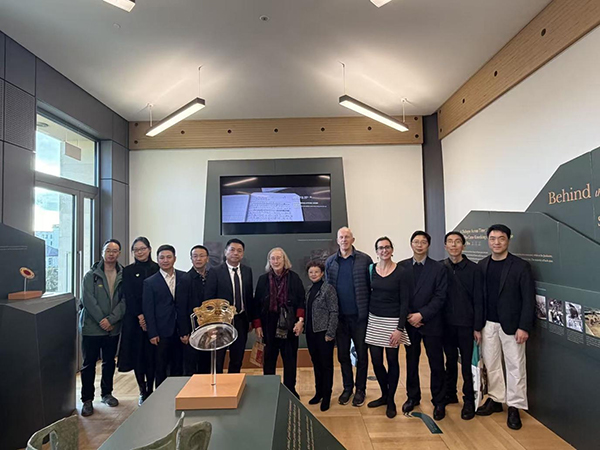From November 8 to 12, the “Behind the Masks: Discovering Sanxingdui and Jinsha” exhibition and an academic symposium were held at St Anne’s College, University of Oxford. The event was jointly sponsored by the Sichuan Provincial Cultural Heritage Exchange and Information Center, the Sanxingdui Museum, and the Jinsha Site Museum, and cohosted by Foreign Language Teaching and Research Press (UK) and Southwest Jiaotong University.

At the Event
The exhibition showcased the archaeological findings from the Sanxingdui site in Guanghan and the Jinsha site in Chengdu, Sichuan province, through multimedia forms such as graphics, images, and videos, introducing the unique artistic accomplishments and spirit realm of the ancient Shu civilization. The opening ceremony on November 8 presented 14 replicas of important cultural relics such as bronzes and gold artifacts, including the “Bronze Sacred Tree”, the tallest known bronze artifact from the Shang and Zhou periods, the most intact “Bronze Standing Figure”, and the “Bronze Altar”, a representative ritual relic of the ancient Shu civilization, along with the exquisitely crafted “Sun and Immortal Bird” gold ornament and gold masks. Augmented Reality (AR) technology was also used to reconstruct the archaeological excavation and the landscapes of the sites, providing visitors with an immersive cultural experience.

At the Event
The opening ceremony was attended by Chinese representatives including Pu Xin, Deputy Director of the Sichuan Provincial Cultural Heritage Administration, Wang Fang, Deputy Director of the Jinsha Site Museum, Feng Shiwei, Deputy Director of the Sanxingdui Museum Management Committee, and Xie Zhenbin, Vice President of the Sichuan Museum. The British representatives included experts and scholars from the University of Oxford, Foreign Language Teaching and Research Press (UK), the Oxford International Centre for Publishing, and other UK universities. Pu Xin, and James Hutchings, representative of the British host organization, both highlighted the success of the exhibition and the continued cooperation between China and the UK in cultural heritage in their speeches.

Sun and Immortal Birds Gold Ornament (3D Printing Artworks)
The Sanxingdui site, discovered in Guanghan, Sichuan in 1927, is hailed as “one of the most significant archaeological discoveries of the 20th century in China”, unveiling a previously unknown chapter of the ancient Shu civilization. The Jinsha site, unearthed in Chengdu in 2001, and the Sanxingdui site sharing the same origin, collectively contribute to shaping the panorama of the ancient Shu civilization. Dame Jessica Rawson, renowned British art historian, archaeologist, sinologist, and Professor of the University of Oxford has described Sanxingdui as “extraordinary, stunning, and unique”, suggesting that its artifacts “reflect not real life, but the thought and imaginary world of the ancient Shu people”.
On the afternoon of November 8, the academic symposium on Sanxingdui and Jinsha was held in the lecture hall of St Anne’s College. Focusing on “Understanding China through Archaeology: History, Culture, and Art”, the symposium brought together many experts and scholars from the fields of archaeology and museology in both China and the UK.
Ms. Wang Fang, Deputy Director and Researcher of the Jinsha Site Museum, delivered the opening address. Dr. Anke Hein, Associate Professor of Archaeology at the University of Oxford, focusing on “Interaction between Mountain Civilizations in Western Sichuan and the Ancient Shu Culture”, explored the cultural ties between the ancient Shu civilization and the eastern rim of the Tibetan Plateau. Professor Li Haichao from the School of Archaeology and Museology, Sichuan University, elaborated on “Resources and Rituals: The Rise and Fall of Ancient Shu and its Resource Interaction Network”, and analyzed the role of resource use and religious rituals in the development of civilization. Dr. Wang Shengyu, Associate Researcher of the Hong Kong Palace Museum, focusing on “Gold Artifacts from Sanxingdui and Jinsha: Light, Space, and a System of Decoration”, explained the symbolic significance of gold artifacts in the aesthetic and religious systems of ancient Shu society. Professor Dame Jessica Rawson delivered concluding remarks for the symposium.
This event stands as a testament to the steadily enhanced cultural exchanges between China and the UK. Foreign Language Teaching and Research Press (UK), Southwest Jiaotong University, and the Sanxingdui Museum have collaborated on multiple events since 2022, including the “Discovering Sanxingdui” dialogue between Chinese and international archaeologists and the “Wonderful Journey of Sanxingdui” interactive program for youth. These activities have drawn broad engagement from UK university and school students, faculty, and the public, and laid a solid foundation for the promotion of the ancient Shu civilization in Britain.
The “Behind the Masks: Discovering Sanxingdui and Jinsha” exhibition and symposium brought together and demonstrated a spectrum of archaeological achievements from Southwest China in the UK. This event stands as another significant accomplishment in Chinese-British collaboration in cultural heritage preservation, academic research, and mutual learning of civilization, further fostering understanding and cultivating appreciation of ancient Chinese civilization and art among overseas audiences.
1、“國際在線”由中國國際廣播電臺主辦。經中國國際廣播電臺授權,國廣國際在線網絡(北京)有限公司獨家負責“國際在線”網站的市場經營。
2、凡本網註明“來源:國際在線”的所有信息內容,未經書面授權,任何單位及個人不得轉載、摘編、複製或利用其他方式使用。
3、“國際在線”自有版權信息(包括但不限于“國際在線專稿”、“國際在線消息”、“國際在線XX消息”“國際在線報道”“國際在線XX報道”等信息內容,但明確標注為第三方版權的內容除外)均由國廣國際在線網絡(北京)有限公司統一管理和銷售。
已取得國廣國際在線網絡(北京)有限公司使用授權的被授權人,應嚴格在授權範圍內使用,不得超範圍使用,使用時應註明“來源:國際在線”。違反上述聲明者,本網將追究其相關法律責任。
任何未與國廣國際在線網絡(北京)有限公司簽訂相關協議或未取得授權書的公司、媒體、網站和個人均無權銷售、使用“國際在線”網站的自有版權信息産品。否則,國廣國際在線網絡(北京)有限公司將採取法律手段維護合法權益,因此産生的損失及為此所花費的全部費用(包括但不限于律師費、訴訟費、差旅費、公證費等)全部由侵權方承擔。
4、凡本網註明“來源:XXX(非國際在線)”的作品,均轉載自其它媒體,轉載目的在於傳遞更多信息,豐富網絡文化,此類稿件並不代表本網贊同其觀點和對其真實性負責。
5、如因作品內容、版權和其他問題需要與本網聯繫的,請在該事由發生之日起30日內進行。